Discover the best tips to visit the Alhambra in Granada, a UNESCO World Heritage Site and the most popular tourist attraction in Spain
By Liza S. | Updated 6 Jun 2024 | Granada | Places To Go |
Login to add to YOUR Favourites or Read Later
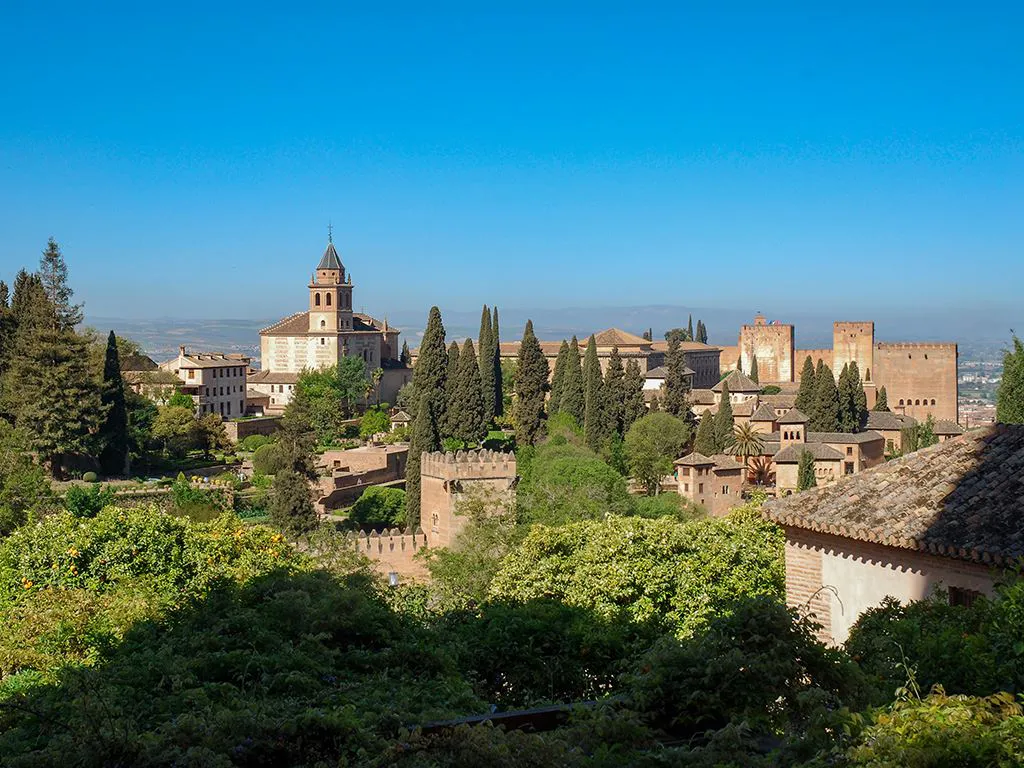
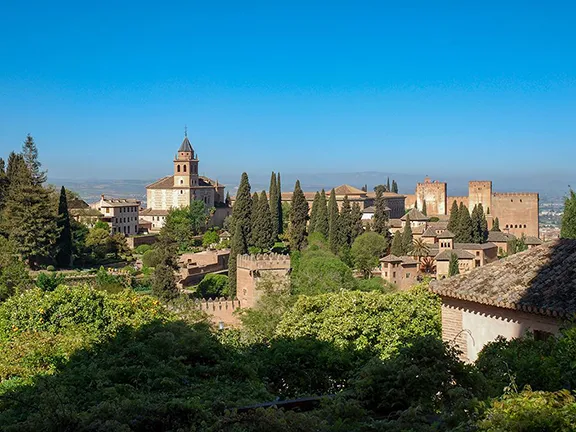
The Alhambra Palace Granada
In 1832, the American romantic traveller, Washington Irving wrote, “Perhaps there never was a monument more characteristic of an age and people than the Alhambra; a rugged fortress without, a voluptuous palace within; war frowning from its battlements; poetry breathing throughout the fairy architecture of its halls.”
At the time, Irving lived in a habitable part of the Alhambra with the caretaker, Doña Antonia-Molina, and her family. Today, it is only possible to experience living within the walls of the Alhambra if you stay at the Parador Hotel or the Hotel America but the Alhambra itself attracts over 3 million visitors each year.
On a visit to Granada, the UNESCO World Heritage Site is undoubtedly the number one attraction on every visitor’s list. If you’re planning to visit or simply want to learn more about this iconic Spanish monument, read more to discover all you need to know about visiting the Alhambra.
The word ‘alhambra’ is Arabic and translates to ‘the Red or Vermillion Castle’ and refers to the colour of the towers and walls in reflected sunlight.
Built during the Nasrid Dynasty, the Alhambra of Granada is a fortified, walled, palatine city designed and built purely to serve the needs of its officials and workforce who in turn looked after the needs of the sultan and his family. Construction began in 1238 and more additions were introduced to the palace complex over the next 100+ years. Most of the Alhambra that we see today was built between 1238 and 1358.
The Alhambra was designated a UNESCO World Heritage Site in 1984, along with the Albayzin and Generalife.
Within the walls of the Alhambra are five distinct areas: the Alcazaba, the Nasrid Palaces, the Charles V Palace (that also contains the Alhambra Museum), the Medina, and the Generalife.
The western section of the Alhambra is taken up with the Nasrid Palaces, reserved for the use of the sultan, his closest family and his administrative officials. In this same area, you’ll also find the Alcazaba and the Charles V Palace (with the Alhambra Museum).
The eastern sections of the Alhambra, easily the largest single area, was taken up by a complete town called the Medina to cater for the Court and the elite guard.
In the northern section, you’ll find the Generalife, a leisure palace surrounded by luxuriant gardens.
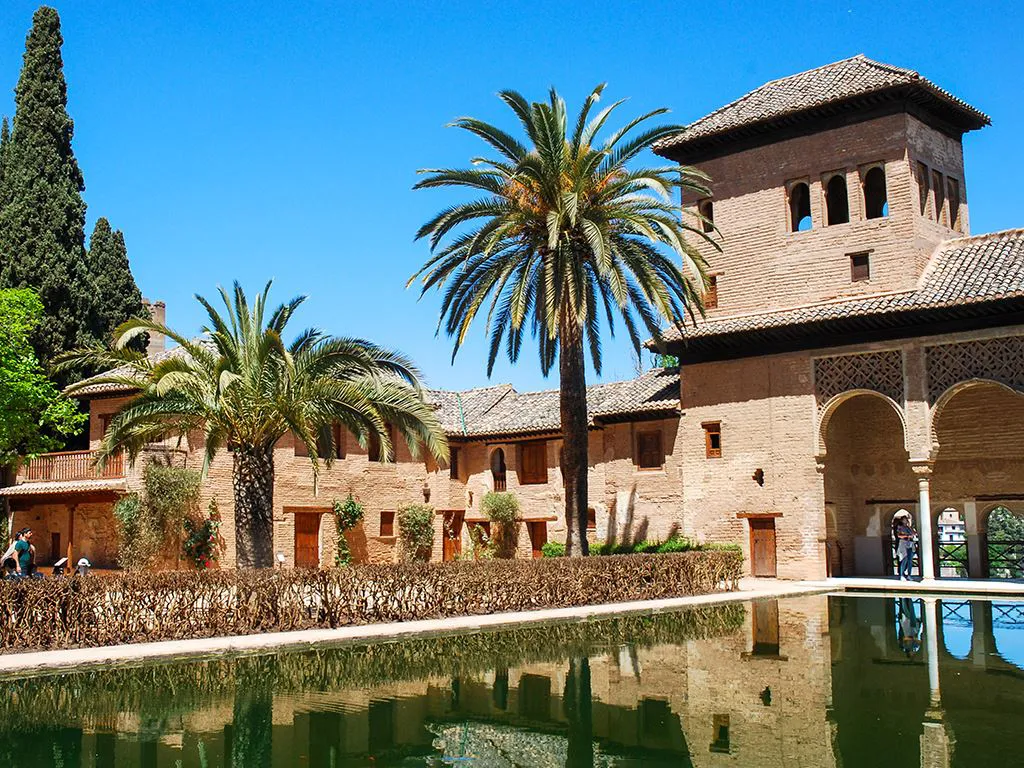
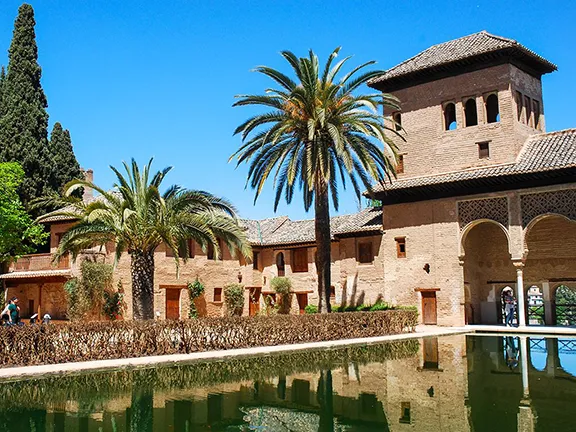
Nasrid Palaces
Needless to say, the Alhambra is an immensely popular attraction in Granada… and yes, Alhambra tickets do sell out!
The #1 mistake that most travellers do is not booking their Alhambra tickets immediately, once they've nailed down their Granada trip dates. We’ve had members of our Visit-Andalucia Facebook group report that they were unable to get last-minute tickets for their visit (there are some options available if tickets are sold out… more on that later!) so once you have confirmed dates for your stay in Granada, I highly highly recommend buying your Alhambra tickets in advance.
I cannot stress how crucial it is to book Alhambra tickets way in advance… believe me, you won’t want to face the disappointment of not having tickets!
Most visitors visit the Alhambra on their own and simply purchase entrance tickets. An Alhambra ticket will provide you with access to everything in the complex.
However, do note that your entry to the Nasrid Palaces is on a timed entry (to avoid overcrowding) and you can only enter each individual place in the Alhambra (that is the Alcazaba, Nasrid Palaces, El Partal and Generalife) once. You can go in and out of the complex itself with the same ticket on the day of entry, if you want to take a lunch break or a rest in the afternoon.
You can buy your entrance ticket here or simply input your visit date below to check availability.
A visit to the Alhambra palace complex can easily take anywhere from three to six hours, depending on your pace so be sure to allocate enough time in your itinerary to fully explore this gem!
If you prefer to learn more about the history of the palace and discover the personalities that lived there, then a guided tour of the Alhambra is definitely the way to go. With a local guide showing you the way, highlighting key features of the palace complex, and sharing the history of the Alhambra, this 3-hour tour will simply zoom by as you immerse yourself in Granada’s fascinating Moorish history.
An Alhambra guided tour is a great option not just for history-lovers but also if you only have a few hours to devote to your visit as you can efficiently see the highlights of the palace in just 3 hours.
I’ve visited the Alhambra both on my own and on a guided tour, and taking the tour was definitely a valuable experience as I learned so much more about the history of the Alhambra. Once the tour is complete, you can still stay within the palace complex to explore and appreciate the palace grounds at your own pace.
Get my recommendations for the best Alhambra tours here.
One last note about Alhambra tickets: don’t forget to bring your passport or ID when you go. The staff does scan your ID upon entry so you need it to enter the Alhambra.
If you are unable to get Alhambra tickets for your visit date because they’re all sold out online, there’s still hope!
Here are my recommendations.
Your first option is to try to join a guided Alhambra tour. A guided tour typically included entrance to the palace and tour providers have their own ticket allocation apart from those allocated for sale to the general public. Depending on how far in future your visit is, you have to browse through several tours to find one with availability. I typically use Get Your Guide or Viator to look for reputable guided tours.
Your second option is to gain entry to the Alhambra with a Granada Card. A Granada Card is a tourist pass that includes entry to several historical monuments in Granada as well as public transportation tickets. There are several card types and you’ll want to get the Granada Card 48H which provides full access to the entire Alhambra complex.
The Granada Card offers value for money if you plan to visit most of the monuments included with the card but if you’re in a pinch and need a last-minute ticket to the Alhambra, this is your best bet. Learn more and purchase the Granada card here. (You can toggle the language from Spanish to English at the top of the page.)
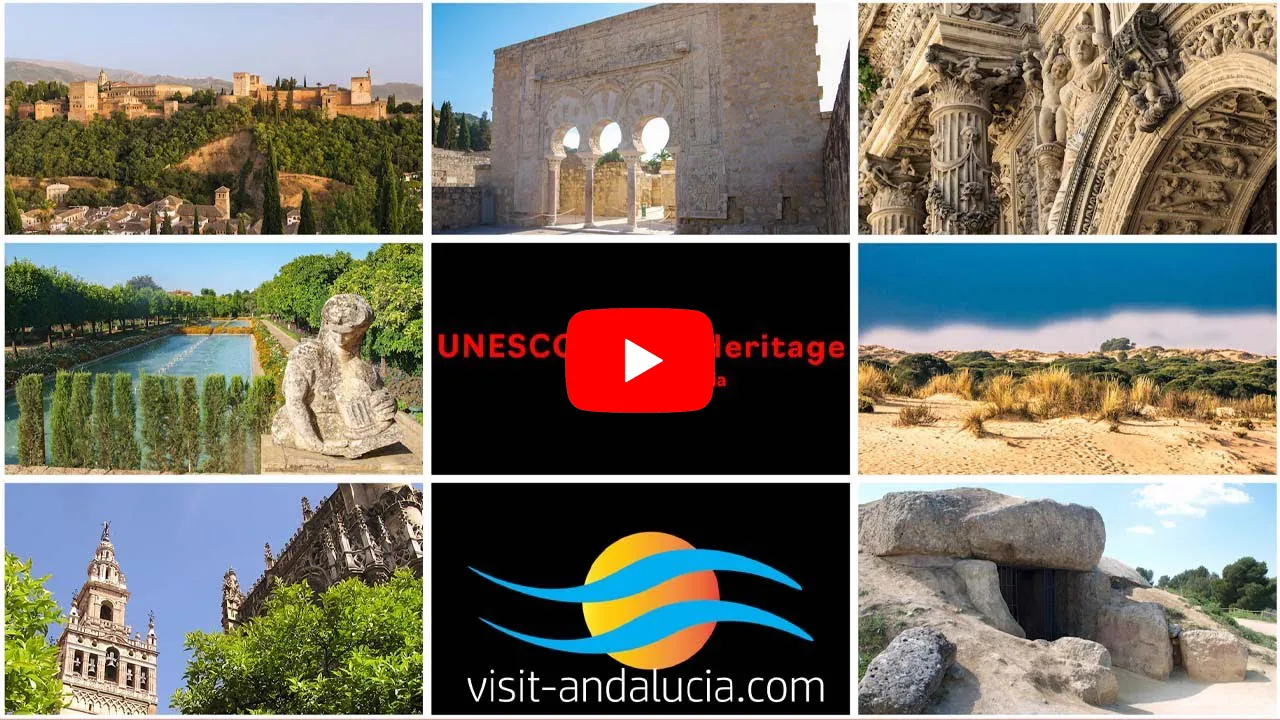
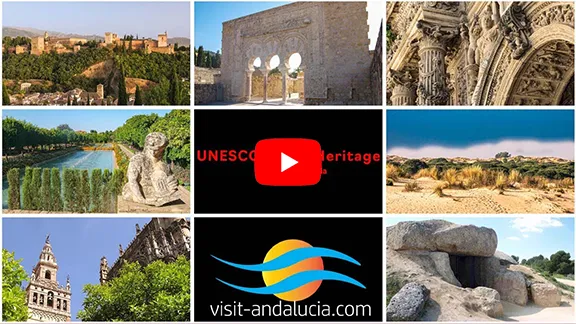
Video By: Julie Evans
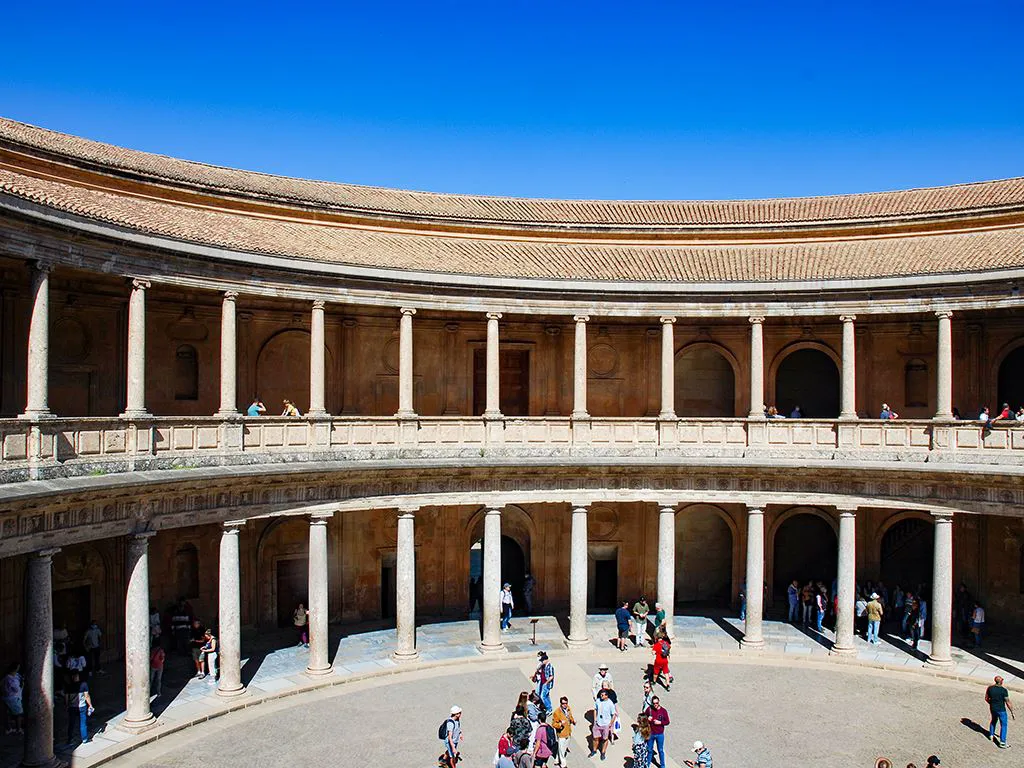

Charles V Palace
You can visit the Alhambra all-year long. There’s no bad time to visit the Alhambra!
If you prefer to avoid the crowds, I suggest timing your visit for the early morning or late afternoon as mid-morning is when most tour groups and guided tours are visiting the palace complex.
Visiting the Alhambra on your own and not sure what to expect? We’ll guide you through the palace complex and offer a suggested itinerary so that you can make the most of your visit.
There are three entrances to the Alhambra: Puerta de la Justicia (Gate of Justice), Puerta de los Carros (Gate of the Carts) and the Ticket Pavillion (which is the main entrance).
Most visitors enter through the turnstiles at Ticket Pavillion which is located at the eastern end of the complex.
If you enter the Alhambra via the Ticket Pavillion, take the path on your left which immediately takes you into the Medina, a walled town, which you’ll have to walk through to get to the Nasrid Palaces. From the Ticket Pavillion to the Nasrid Palaces, be sure to allocate about 10 to 15 minutes of walking time.
Rather than take public transport from the city centre to the Alhambra, an alternative is to walk from Via Reyes Catolicos up Ctr. de Gomerez and through the Puerta de las Granadas, an historic arch carrying the Imperial Shield.
Once through the gate, veer left up Cta Empedrada, through a shady, cool, green woodland until you reach the Puerta de la Justicia. This gate, with a typical zig zag, cobbled entrance takes you into the Alhambra, avoiding the turnstiles.
If you’re staying in Albaicin, you may find that this entrance at Puerta de la Justicia is more convenient for you. This entrance is also closest to the Nasrid Palace which I recommend doing first on your Alhambra visit.
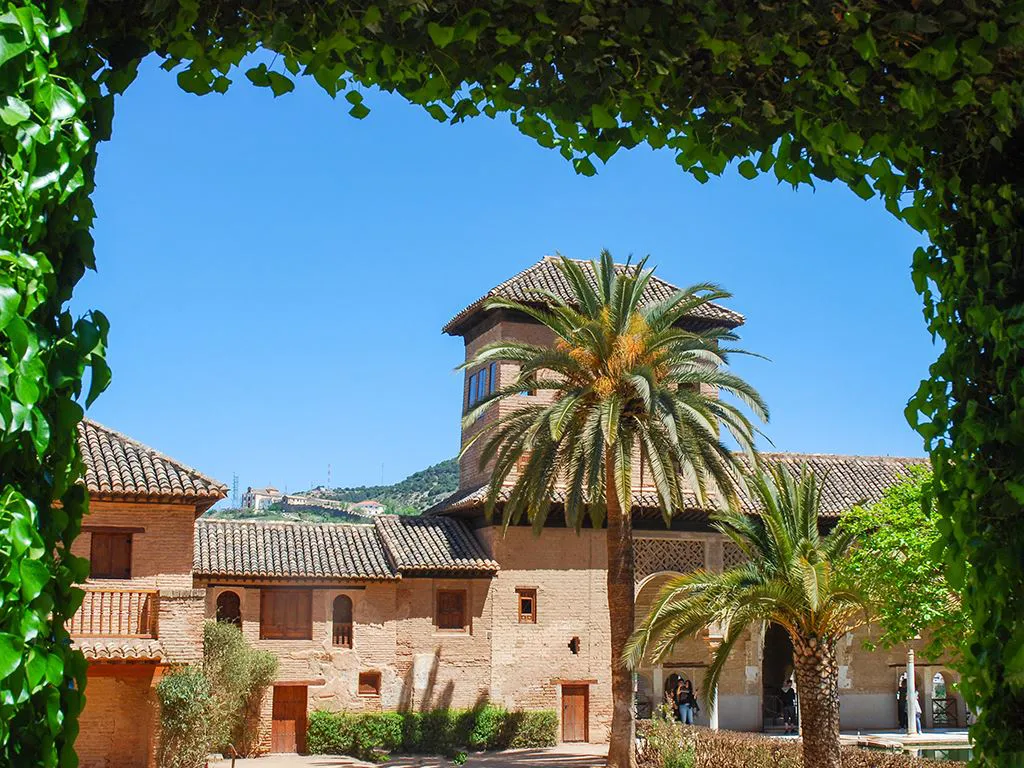

Exterior of the Nasrid Palaces
Regardless of which entrance you use to access the Alhambra, I recommend visiting the Nasrid Palaces first, if possible.
Entry to the Nasrid Palaces is controlled by tickets either purchased separately or as part of a composite ticket that includes the rest of the Alhambra. The tickets are timed to limit the number of people in the palaces at any given time and you can choose your entry time when you purchase your ticket.
It is essential that you join the queue before that time. Entry timeslots are every 30 minutes so you have a 30-minute window to enter the Nasrid Palaces with your ticket. I’ve seen people get turned away for being late so it’s better to be safe than sorry!
Remember: if you’re entering through the Ticket Pavillion, give yourself an additional 10 to 15 minutes to make your way from there to the entrance of the Nasrid Palaces.
I suggest seeing the Nasrid Palaces first as it’s the only location with timed tickets and it’s much easier to tick it off your list first thing instead of trying to see everything else and then having to head there for your timed entry. Also, in my opinion, the Nasrid Palaces is the highlight of the entire complex and seeing it first sets the tone for your visit.
So what is the Nasrid Palaces?
The Nasrid Palaces are a complex of palaces, the residence of the kings of Granada. Their construction was started by the founder of the dynasty, Alhamar, in the thirteenth century, although the buildings that have survived to our time date mainly from the fourteenth century.
The walls of these palaces enclose the refinement and the delicateness of the last Hispano-Arab governors of al-Andalus, the Nasrids.
Three palaces form these premises: The Mexuar, The Comares, or Yusuf I Palace and The Palace of Mohammed V or of the Lions.
The Mexuar Palace has seen many alterations and renovations by successive monarchs since it was first built and it is impossible to determine when construction started. The situation was not helped when, in 1590, a powder magazine exploded causing quite a bit of damage.
The Mexual Hall is decorated on its lower part with tiles and plaster friezes above taking the eye to the coffered ceiling. At the back of the hall is the chamber used by the king to receive visitors and for meetings with the council.
The Comares Palace was the official residence of the king, Yusuf I (1318 – 1354). At its centre is the Patio de los Arrayanes with rooms around the sides. Notable amongst them are the Salsa de Barca and the Hall of the Ambassadors.
The Hall of the Ambassadors is the most majestic hall of the palace complex. Yusuf I wanted to amaze and impress his visitors and the decorations here are exquisite. Unfortunately for Yusef, he did not live long enough to see the finished result. The Comares Palace was finished by his son, Mohammed V (1339 – 1391).
Do not miss the Comares Tower with its fantastic views over the Darro valley.
When Mohammed V succeeded his father Yusuf I, he did more than just finishing the alterations that his father had started. He built what would become his greatest work of art: the Palacio de los Leones (Palace of the Lions). This palace comprised the private chambers of the royal family.
In the Palacio de los Leones, Nasrid art achieved its greatest degree of magnificence.
The beauty of this palace shows incomparable sensibility and harmony. Light, water, colours and exquisite decoration turn this palace into a pleasure for the senses. The abstract and geometric decoration allow a more naturalistic style to dominate, a result of Christian influence, the friendship between Mohammed V and the Christian king Pedro I (The Cruel).
The Palace of the Lions comprises a central patio, the Court of Lions, surrounded by several galleries with columns forming a cloister. From the central patio, you may access the different halls: the Sala de los Mocárabes (Hall of the Mozarabes) to the west, the Sala de los Reyes (Hall of the Kings) to the east, the Sala de Dos Hermanas (Hall of the Two Sisters), the Sala de los Ajimeces (Hall of the Ajimeces) and Mirador de Daraxa (Daraxa's Mirador) to the north and the Sala de los Abencerrajes (Hall of the Abencerrajes) and the Harén (Harem) to the south.
The Court of Lions contains the emblematic lion fountain, built in marble and depicting twelve lions supporting a water bowl. The marble came from the Macael quarries in Almeria. The original fountain had a second bowl above the first.
The Nasrid Palaces were a place for relaxation and monuments to the power and influence of the Nasrid rulers. As Muslims, the Nasrids appreciated the beauty of trees, shrubs and plants combined with that essential element in short supply in their homelands, water.
The Nasrid Palace gardens are a series of formal gardens, a perfect symmetry of water and plants, designed for reflection, a perfect end to the tour of this magnificent palace.
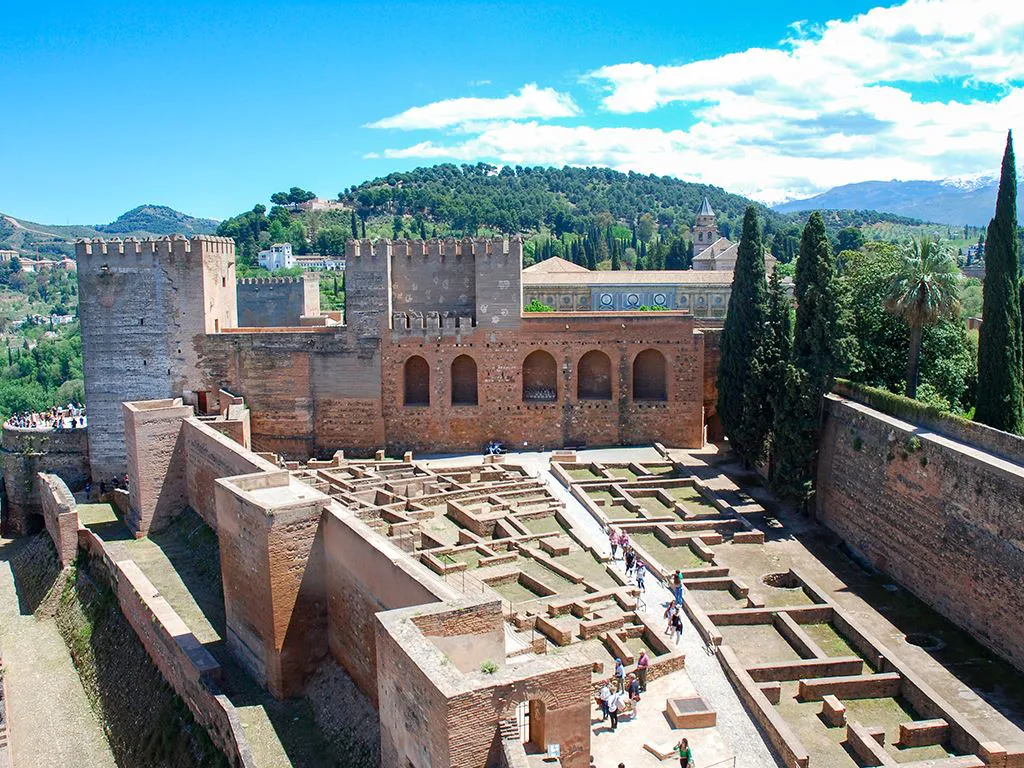

Alcazaba in the Alhambra, Granada
The Alcazaba, next on our suggested Alhambra itinerary, is the oldest part of the Alhambra. After exiting the Nasrid Palace, you’ll have to circle back to the area where you entered the Nasrid Palaces as the Alcazaba entrance is located nearby.
The Alcazabar was a self-contained, and walled, town. It housed the elite guard and their supporting infrastructure including food and grain stores and water cisterns. Its walls connected with the walls of Granada city proper. It is, in effect, a citadel within a citadel.
The towers and walls of the Alcazaba are designed to house and protect the Sultan and his servants and guards. Their privileged position in the Alcazabar which, in the event of an attack would become the last refuge of the defenders, indicated the occupants were of higher rank than those individuals housed in the Medina.
The Alcazaba occupies the most western and highest part of the Alhambra and the views over the city of Granada from the towers and battlements are spectacular.
The next stop on the tour is the Palace of Charles V which is situated next to the Nasrid Palaces.
This Renaissance-style building was started in 1527 and, due to lack of funds, never finished. Some people have the opinion that it is the finest Renaissance building outside of Italy. Inside the palace is the Alhambra Museum that is definitely worth a visit.
You can read our article on the Alhambra Museum here.
If you decide to enter the Alhambra via the Ticket Pavillion, the first thing you’ll see in the Alhambra is the Medina, a walled town. On our suggested Alhambra itinerary, you’ll get the chance to explore the Medina after visiting the Nasrid Palaces, the Alcazaba, and the Palace of Charles V and Alhambra Museum.
Following the War of Independence (1808 – 1813), the buildings in the Medina were left in ruins, and part of the wall and its towers had to be rebuilt almost entirely. You can see the foundations of the buildings, as well as the wall from the inside, with the steps of the round, battlements and merlons and a great view of the Generalife from the east.
The Medina had several public toilets, ovens, workshops, silos and cisterns and the houses of high officials, employees and servants of the court.
Next on our suggested route is the Generalife. You’ll have to exit the Medina and follow the signs leading you to the Generalife and its gardens.
The Generalife stands as a testament to the exquisite artistry and architecture of the Nasrid dynasty. Originally conceived in the 13th century as the private retreat of the Nasrid monarchs, this palace offers visitors a unique glimpse into the leisurely pursuits of Moorish royalty during the Middle Ages.
One of the main draws of the Generalife is its intricate water features, which include fountains, channels, and pools, all interwoven with meticulously manicured plants. The sound of trickling water provides a soothing backdrop, evoking an ambience of tranquillity.
As you meander through the gardens, the Patio de la Acequia (Court of the Water Channel) is a highlight, featuring a long pool framed by flowerbeds, fountains, and colonnades. It's a stunning example of the Nasrids' ability to blend practical water management with aesthetic design.
Venture inside the palace itself to experience beautifully decorated rooms adorned with Moorish stucco, intricate woodwork, and elegant tile mosaics known as 'azulejos'. These designs provide a direct insight into the tastes and artistry of the period and offer a snapshot of the rich history of this Andalucian region where cultures converged.
For more on the Generalife, click here for our full Generalife guide.
There are parts of the Alhambra complex which are free admission.
Once through Puerta de la Justicia, you can visit the Carlos V Palace and the Alhambra Museum. You can then walk through the Medina as far as the branch road that takes you to the Generalife.
Rising above the modern lower town, the Alhambra and the Albaycín, situated on two adjacent hills, form the medieval part of Granada. To the east of the Alhambra fortress and residence are the magnificent gardens of the Generalife, the former rural residence of the emirs who ruled this part of Spain in the 13th and 14th centuries. The residential district of the Albaycín is a rich repository of Moorish vernacular architecture, into which the traditional Andalusian architecture blends harmoniously.
What is the Alhambra?
The Alhambra is a palace and fortress complex located in Granada, Spain. Originally constructed as a small fortress in AD 889 and rebuilt in the mid-13th century by the Nasrid dynasty, it is now one of the finest examples of Islamic art and architecture in Europe.
How do I get tickets for the Alhambra?
Tickets can be purchased online. Due to its popularity, it's advisable to book tickets well in advance to ensure availability, especially during peak tourist seasons.
Is there a limit to the number of visitors to the Alhambra per day?
Yes, to preserve the site, there's a daily limit on the number of visitors. This is another reason to book your tickets in advance.
Are there guided tours of the Alhambra available?
Yes, many companies offer guided tours of the Alhambra. These tours can provide in-depth historical context and insights that you might miss if exploring on your own. This 3-hour guided tour comes highly recommended. You can also check out my recommendations of the best Alhambra tours here.
How much time should I allocate for my Alhambra visit?
Ideally, you should set aside at least 3 hours to explore the Alhambra comprehensively. This includes time for the Generalife gardens, the Nasrid Palaces, and the Alcazaba fortress.
Is the Alhambra accessible for people with disabilities?
While many areas of the Alhambra are accessible, some parts might be challenging due to the historic nature of the construction. It's recommended to check the official website or contact the site directly for specific accessibility information.
Are there food and drink facilities on-site in the Alhambra?
Yes, there are a few cafés and a restaurant within the Alhambra complex. However, visitors are also free to bring their own snacks and water. As your Alhambra ticket allows same-day re-entry, you can also consider leaving the palace complex to have lunch at a nearby restaurant.
What's the best time to visit the Alhambra?
Early morning or late afternoon are ideal times for a visit as the site tends to be less crowded and the weather is milder. The views during sunset are particularly stunning.
Is there a dress code to enter the Alhambra?
There's no strict dress code for the Alhambra. However, it's advisable to wear comfortable shoes due to the amount of walking involved, and to dress respectfully, keeping in mind it's a historical and cultural site.
Need help planning your visit? Our Granada itineraries can help:
For more on Granada, check out our other articles.
Travelling to/around Spain and need some help? Here are our favourite travel resources.
We usually use Booking.com to look for hotels or apartment rentals. Lots of choice & you can unlock more discounts with their Genius loyalty programme!
To research transportation options around Spain, we like using Omio. It’s an easy way to compare different modes of transport and prices in one place. To search train routes, schedules, and prices, we recommend using Trainline.
Renting a car gives you the ultimate freedom to explore Andalucia at your own pace. Click here to compare car rental prices. (You’ll be surprised at how affordable it is in Spain!)
For last-minute holiday deals, check out Expedia UK.
Looking for things to do? Viator has a huge catalog of activities and tours across many cities in Spain. We also love Get Your Guide!
Guruwalk is our favourite platform to find the best free walking tours in a city.
For money transfers or spending overseas in foreign currency, Wise is our favorite borderless banking service (we love their debit card that's without fees!).
Travel insurance is a must to protect against emergencies and unexpected incidents. Get a quote from SafetyWing here.
For an easy way to stay connected on the road, get an eSim from Airalo. It's affordable and, best of all, you'll be connected the moment you arrive!
Visit the official website for the Alhambra